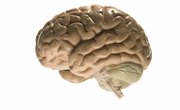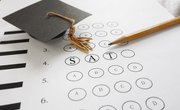Normal Ranges for an IQ
An intelligence quotient, or IQ, test does not directly a measure of intelligence, but rather components of intelligence such as spatial reasoning, vocabulary and visualization. Different tests emphasize different areas of intelligence. Average IQ is often used to place yourself among others in society in terms of intelligence and understanding. While intelligence tests are not needed for society, many people look to them for personal interest or academic achievement needs.
Having a high IQ may lead to more opportunities available to you in certain career fields, as well as showing your mental age. The WISC, or Wechsler Intelligence Scale for Children, often looks to IQ for advanced placement in academics, as certain students are better test-takers than others. While a person’s IQ can change with time and education, IQ score ranges can also display intellectual disabilities. While the average IQ score can go up with chronological age of a person, certain cognitive abilities can be displayed with human intelligence in IQ levels.
Mental ability and mental health is also understood by IQ for problem-solving, emotional intelligence, and other important WAIS needs. Low IQ, or lower IQ scores, do not necessarily mean a disability or lack of intelligence as compared to those with high IQ or higher IQ scores in the same age group, but it can be a determinant of certain learning differences for related year-olds.
IQ test scores are defined in relation to an average of 100. However, different versions of the IQ test place different emphases on scores farther from 100.
Calculation in Relation to 100
The standard of scoring on an IQ test is based on a scale from zero to 200 that is based on the general average score in the larger population. IQ scores are defined so the average IQ score for a population is 100; the most common scores will also fall near or around the IQ level of 100.
When IQ tests were first being developed, they would take a person’s mental age and compare it to their chronological age and multiply that ratio by 100. For example, a mental age higher than the chronological age would result in a number over 100 while a mental age lower than the chronological age would be less than 100.
A graph of the most common IQ scores will appear as a hill with its peak at 100. This is called a bell curve. So for any IQ scale, normal intelligence will be around 100. If you score 100 on an IQ test, you're in the 50th percentile of scoring. This means you've scored higher than 50 percent of people who've taken the test.
Stanford-Binet Scale
The Stanford-Binet test was created by the French Psychologist Alfred Binet and is defined as an intelligence test and scale that was developed in the early 20th century to evaluate children's intelligence and determine their IQ scores. A Stanford-Binet test measures five qualities of intelligence: knowledge, fluid reasoning, quantitative reasoning, visual-spatial processing, and working memory.
In the Stanford-Binet scale, levels of intelligence are defined by their distance from 100. Average intelligence is defined between IQ test scores of 90 and 110 points, with the standard deviation of 80 to 89 being defined as "dullness" and high IQ score ranges of 110 to 120 as "superior intelligence." A genius-level score on the Stanford-Binet scale is over 140, while scores under 70 indicate mental retardation.
Wechsler Scale
The Wechsler Adult Intelligence Scale is another intelligence test that was created in the 1950s to measure intelligence in adults and adolescents as another form of an IQ test. Both the Wechsler and Stanford-Binet scales use a standard deviation of 15 points from the average. This means that 68 percent of scores fall between 85 and 115, and 95 percent of scores fall between 70 and 130.
Only 1 percent of scores fall below 15 or above 145. Wechsler's scale measures four areas of intelligence: verbal comprehension, perceptual reasoning, working memory, and processing speed, which are combined to provide a total IQ score. Scores between 80 and 119 are defined as a lower IQ, with scores in the 80s as "low average" and scores in the 110s as "high average." The Wechsler scale does not include a "genius" level, but defines scores over 130 as "very superior."
Cattell's Scale
The Cattell Culture Fair III intelligence test is designed to test intelligence while avoiding a bias toward Western students. The Cattell test, along with the Wechsler, is used as a qualification for Mensa. The Cattell Scale, like other IQ scales, places its average IQ score at 100. However, it uses a standard deviation of 24, rather than 15, in its scoring system, allowing it to provide a more accurate assessment of scores that are farther from 100.
The Cattell scale defines average intelligence between 100 and 119, with scores in the 90s as "below average" and in the 120s and 130s as "above average." A genius-level IQ score falls above 160 points, making this a high IQ.
IQ Scores in Age
A parent can test the IQ of their two-year-old child to see if they may be gifted. However, with as the child ages, so does their IQ. The best time for a child to be tested is when they are five years old as they start to enter school so that the school is able to place them in the right class. Our IQ test scores change as we age can change. In America, the average IQ score for 16 to 17-year-olds is 108, 20 to 24-year-olds is 99, 35 to 44-year-olds is 101, and over 65-year-olds is 114.
Related Articles
References
- IQ Test Experts: How Do You Interpret The IQ Test Scores?
- Psych Central: Types of Psychological Testing
- Assessment Psychology Online: IQ Classifications
- IQ Comparison Site: IQ Basics
- Stanford-Binet Intelligence Scales (SB5), Fifth Edition
- High IQ Pro: What Is An IQ Test? How To Test IQ?
- Madsen Pirie: What IQ Measures and Why a High IQ is Not “Genius Level”
- Psychology Encyclopedia: Stanford-Binet Intelligence Scales
Writer Bio
Jon Zamboni began writing professionally in 2010. He has previously written for The Spiritual Herald, an urban health care and religious issues newspaper based in New York City, and online music magazine eBurban. Zamboni has a Bachelor of Arts in religious studies from Wesleyan University.










